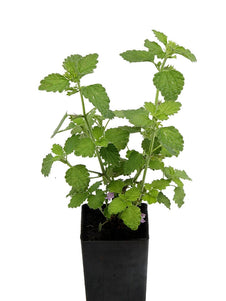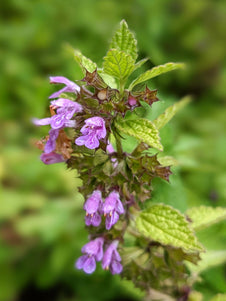









Black Horehound
Black Horehound
- In stock, ready to ship
- Inventory on the way

Usually available: All year
Life cycle: Perennial
Height: 30 - 90cm
Position: Sun / part shade
Soil preference: Well drained
This is how we pack and send your Herb Plants to all states except TAS & WA
You will receive
- 1 Black Horehound Herb Plant in a 50 X 75mm tube - General growing instructions
All of our Herb Plants are grown organically with certified organic potting mixes and fertilizers
Botanical Name: Ballota nigra
Black Horehound is an herbaceous perennial growing from 30 to 90 cm high and 80cm wide. It has stout, branching stems and a fibrous root system. It may be recognised by the clusters of hairy flowers, identified by the tubular calyx and two lipped corolla. The colour may range from reddish purple to an occasional white flower. Around 15-30 flowers are held in dense whorls with the stalk extending above the main plant. The leaves have a serrated edge and are oval lanceolate to heart shaped, ranging from 3-8cm long. They are a dull green colour, covered in soft grey hairs and quite wrinkled on the upper surface with conspicuous veins. The leaves are arranged in pairs on the stem, with each pair being positioned at right angles to the pair above and below it.
The Ballota genus is native or naturalised in many areas, including temperate regions of the Eastern Hemisphere, much of Europe including Britain and from Scandinavia down to northern Africa and the Eastern Mediterranean. It may also be known as Black Stinking Horehound due to the offensive odour. Ballota nigra was first described by Linnaeus in 1753 with a likely reference to the Greek word ‘ballo’ which means ‘to reject’. The plant grew in fields but local cows rejected the plant, supposedly due to its odour (and probably distastefulness). The word ‘nigra’ means dark and may refer to the darkened colour of the leaves when dried.
There is some speculation about where the common name for this plant name originated. The word ‘hore’ is likely derived from the Old English ‘har’ which developed into ‘hoary’ meaning downy or hairy. The addition of ‘hound’ may have come from the word ‘hune’, meaning plant. Some writers have noted that modern herbalists refer to the plant as the ‘seed of Horus’ the ancient god. However, this is a reference to White Horehound and a local practice of linking the name to the ‘hairyness’ of the plant seems more likely.
Growing Conditions
Ballota nigra grows easily in cultivation and like sun or dappled shade. It prefers well drained, loose alkaline soil in the natural environment, but will tolerate acid soils to pH 5 in gardens. Temperatures down to -5 to 10C are tolerated and it will grow in elevations up to 1300m. Flowers appear in summer, with bees as active pollinators.
This plant is nitrophilius and grows well in disturbed ground such as waste areas and by roadsides. Black Horehound may self sow under the right conditions, but if planting the first time sow the seed in spring and wait 3-6 weeks for germination. Established plants may also be divided in spring.
Medicinal Uses
Ballota nigra has a variety of uses in herbal and old traditional medicine, but today it is more often an ornamental garden plant. It does have a strong odour and taste so modern herbalists do seem to restrict use of this plant. The above ground parts of the plant are often used dry. However, a liquid extract or syrup may be made from fresh plants. They should be harvested by picking the stems when the flowers are blooming.
Black Horehound contains the diterpenoids; marrubiin, ballonigrin, ballotinone and ballotenol and some phenylpropanoids known to be antioxidants. Black Horehound should not be confused with White Horehound (Marrubium vulgare), although they are sometimes used together for medicinal purposes.
Historically Black Horehound has been used for many purposes including; nausea, vomiting, spasms, cough, whooping cough, relieving symptoms of nervous disorders, assisting with mild sleep problems and increasing bile flow. It also is used to regulate and increase menstrual flow, digestive complaints, as a mild sedative, as a treatment for intestinal worms, treatment for gout, and as an astringent.
Note that this plant is not recommended for pregnant and breastfeeding women. The chemicals in the plant may interfere with pregnancy maintaining hormones and lead to miscarriage. Ironically some sites recommend treating motion induced nausea, such as morning sickness with Black Horehound.
It is also important that people taking medication for Parkinson’s Disease avoid Black Horehound. The chemicals in the plant may affect medications because they affect brain chemistry and could cause overdosing and lead to increased side effects or enhanced intended effects. A similar warning is suggested for people being treated for schizophrenia and psychotic disorders.
All information provided on this website is for informational purposes only. Please seek professional advice before commencing any treatment.





